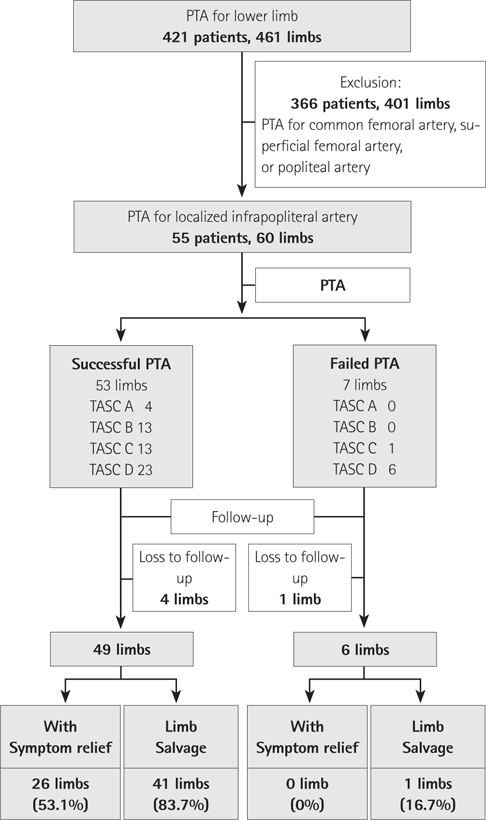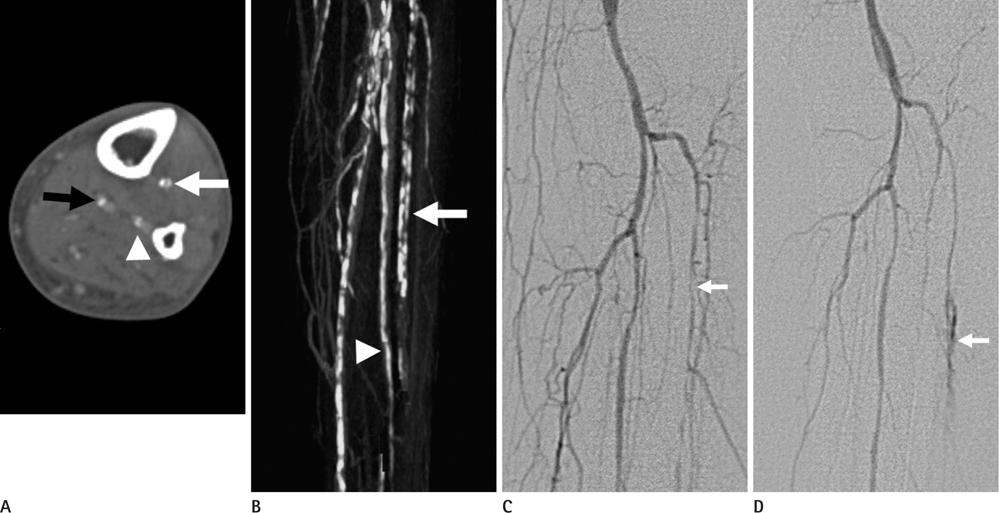J Korean Soc Radiol.
2011 Sep;65(3):217-228.
Infrapopliteal Percutaneous Transluminal Balloon Angioplasty: Clinical Results and Influence Factors
- Affiliations
-
- 1Department of Radiology, Chonnam National University Hospital, Gwangju, Korea. kjkrad@chonnam.ac.kr
- 2Department of Orthopedic Surgery, Chonnam National University Hospital, Gwangju, Korea.
Abstract
- PURPOSE
To assess the efficacy of percutaneous transluminal angioplasty (PTA) in patients with infrapopliteal arterial disease, and to determine the influencing factor for prognosis.
MATERIALS AND METHODS
A total of 55 patients (60 limbs) with infrapopliteal arterial stenosis or occlusion underwent PTA. Atherosclerotic risk factors, clinical symptoms, TransAtlantic Inter-Society Consensus (TASC) classification, and vascular wall calcification were evaluated before PTA. The number of patent infrapopliteal arteries was estimated, and the outcome was evaluated by symptom relief and limb salvage.
RESULTS
Technical success was achieved in 53/60 limbs (88.3%) and 81/93 arteries (87.1%), TASC classification (p = 0.038) and vascular calcification (p = 0.002) influenced on technical failure. During follow-up, 26 of 55 limbs (47%) achieved symptom relief and 42/55 limbs (76%) underwent limb salvage. Non-diabetic patients (9/12, 75%) were superior to diabetic patients (17/43, 40%) in terms of symptom relief (p = 0.024). TASC classification and vascular wall calcification influenced on symptom relief and limb salvage. The number of patent infrapopliteal arteries after PTA influenced symptom relief (p < 0.001) and limb amputation (p = 0.003).
CONCLUSION
PTA in patients with chronic critical limb ischemia is worthwhile as a primary treatment. The influence factors should be considered before PTA, and PTA should be performed in as many involved arteries as possible.
MeSH Terms
Figure
Reference
-
1. Söder HK, Manninen HI, Jaakkola P, Matsi PJ, Räsänen HT, Kaukanen E, et al. Prospective trial of infrapopliteal artery balloon angioplasty for critical limb ischemia: angiographic and clinical results. J Vasc Interv Radiol. 2000; 11:1021–1031.2. Kuusela J, Manninen HI, Karhapää P. Infrapopliteal balloon angioplasty for chronic critical limb ischemia in diabetic patients with uremia: when is it worth the effort? J Vasc Interv Radiol. 2009; 20:342–346.3. Yasuhara H, Hattori T, Shigeta O. Significance of phlebosclerosis in non-healing ischaemic foot ulcers of end-stage renal disease. Eur J Vasc Endovasc Surg. 2008; 36:346–352.4. Bakal CW, Sprayregen S, Scheinbaum K, Cynamon J, Veith FJ. Percutaneous transluminal angioplasty of the infrapopliteal arteries: results in 53 patients. AJR Am J Roentgenol. 1990; 154:171–174.5. Varty K, Bolia A, Naylor AR, Bell PR, London NJ. Infrapopliteal percutaneous transluminal angioplasty: a safe and successful procedure. Eur J Vasc Endovasc Surg. 1995; 9:341–345.6. Löfberg AM, Lörelius LE, Karacagil S, Westman B, Almgren B, Berqgvist D. The use of below-knee percutaneous transluminal angioplasty in arterial occlusive disease causing chronic critical limb ischemia. Cardiovasc Intervent Radiol. 1996; 19:317–322.7. Siablis D, Karnabatidis D, Katsanos K, Diamantopoulos A, Spiliopoulos S, Kagadis GC, et al. Infrapopliteal application of sirolimus-eluting versus bare metal stents for critical limb ischemia: analysis of long-term angiographic and clinical outcome. J Vasc Interv Radiol. 2009; 20:1141–1150.8. Manzi M, Fusaro M, Ceccacci T, Erente G, Dalla Paola L, Brocco E. Clinical results of below-the knee intervention using pedal-plantar loop technique for the revascularization of foot arteries. J Cardiovasc Surg (Torino). 2009; 50:331–337.9. Norgren L, Hiatt WR, Dormandy JA, Nehler MR, Harris KA, Fowkes FG. TASC II Working Group. Inter-Society Consensus for the Management of Peripheral Arterial Disease (TASC II). J Vasc Surg. 2007; 45:Suppl S. S5–S67.10. Giles KA, Pomposelli FB, Spence TL, Hamdan AD, Blattman SB, Panossian H, et al. Infrapopliteal angioplasty for critical limb ischemia: relation of TransAtlantic InterSociety Consensus class to outcome in 176 limbs. J Vasc Surg. 2008; 48:128–136.11. Flueckiger F, Lammer J, Klein GE, Hausegger K, Pilger E, Waltner F, et al. Percutaneous transluminal angioplasty of crural arteries. Acta Radiol. 1992; 33:152–155.12. Aulivola B, Pomposelli FB. Dorsalis pedis, tarsal and plantar artery bypass. J Cardiovasc Surg (Torino). 2004; 45:203–221.13. Nehler MR, Moneta GL, Edwards JM, Yeager RA, Taylor LM Jr, Porter JM. Surgery for chronic lower extremity ischemia in patients eighty or more years of age: operative results and assessment of postoperative independence. J Vasc Surg. 1993; 18:618–624. discussion 624-626.14. Pomposelli FB Jr, Marcaccio EJ, Gibbons GW, Campbell DR, Freeman DV, Burgess AM, et al. Dorsalis pedis arterial bypass: durable limb salvage for foot ischemia in patients with diabetes mellitus. J Vasc Surg. 1995; 21:375–384.15. Faglia E, Dalla Paola L, Clerici G, Clerissi J, Graziani L, Fusaro M, et al. Peripheral angioplasty as the first-choice revascularization procedure in diabetic patients with critical limb ischemia: prospective study of 993 consecutive patients hospitalized and followed between 1999 and 2003. Eur J Vasc Endovasc Surg. 2005; 29:620–627.16. Nasr MK, McCarthy RJ, Hardman J, Chalmers A, Horrocks M. The increasing role of percutaneous transluminal angioplasty in the primary management of critical limb ischaemia. Eur J Vasc Endovasc Surg. 2002; 23:398–403.17. Dormandy JA, Rutherford RB. Management of peripheral arterial disease (PAD). TASC Working Group. TransAtlantic Inter-Society Consensus (TASC). J Vasc Surg. 2000; 31:S1–S29.18. Fleisher LA, Beckman JA, Brown KA, Calkins H, Chaikof E, Fleischmann KE, et al. ACC/AHA 2006 guideline update on perioperative cardiovascular evaluation for noncardiac surgery: focused update on perioperative beta-blocker therapy: a report of the American College of Cardiology/American Heart Association Task Force on Practice Guidelines (Writing Committee to Update the 2002 Guidelines on Perioperative Cardiovascular Evaluation for Noncardiac Surgery) developed in collaboration with the American Society of Echocardiography, American Society of Nuclear Cardiology, Heart Rhythm Society, Society of Cardiovascular Anesthesiologists, Society for Cardiovascular Angiography and Interventions, and Society for Vascular Medicine and Biology. J Am Coll Cardiol. 2006; 47:2343–2355.19. Faglia E, Clerici G, Caminiti M, Curci V, Clerissi J, Losa S, et al. Mortality after major amputation in diabetic patients with critical limb ischemia who did and did not undergo previous peripheral revascularization Data of a cohort study of 564 consecutive diabetic patients. J Diabetes Complications. 2010; 24:265–269.20. Veith FJ, Gupta SK, Wengerter KR, Goldsmith J, Rivers SP, Bakal CW, et al. Changing arteriosclerotic disease patterns and management strategies in lower-limb-threatening ischemia. Ann Surg. 1990; 212:402–412. discussion 412-414.21. Siablis D, Karnabatidis D, Katsanos K, Kagadis GC, Kraniotis P, Diamantopoulos A, et al. Sirolimus-eluting versus bare stents after suboptimal infrapopliteal angioplasty for critical limb ischemia: enduring 1-year angiographic and clinical benefit. J Endovasc Ther. 2007; 14:241–250.22. Watson HR, Schroeder TV, Simms MH, Buth J, Horrocks M, Norgren L, et al. Relationship of femorodistal bypass patency to clinical outcome. Iloprost Bypass International Study Group. Eur J Vasc Endovasc Surg. 1999; 17:77–83.23. Ballard JL, Killeen JD, Smith LL. Popliteal-tibial bypass grafts in the management of limb-threatening ischemia. Arch Surg. 1993; 128:976–980. discussion 980-981.24. The Iloprost Bypass International Study Group. Effects of perioperative iloprost on patency of femorodistal bypass grafts. Eur J Vasc Endovasc Surg. 1996; 12:363–371.25. Ferraresi R, Centola M, Ferlini M, Da Ros R, Caravaggi C, Assaloni R, et al. Long-term outcomes after angioplasty of isolated, below-the-knee arteries in diabetic patients with critical limb ischaemia. Eur J Vasc Endovasc Surg. 2009; 37:336–342.26. Brillu C, Picquet J, Villapadierna F, Papon X, L'Hoste P, Jousset Y, et al. Percutaneous transluminal angioplasty for management of critical ischemia in arteries below the knee. Ann Vasc Surg. 2001; 15:175–181.27. Dorros G, Jaff MR, Dorros AM, Mathiak LM, He T. Tibioperoneal (outflow lesion) angioplasty can be used as primary treatment in 235 patients with critical limb ischemia: five-year follow-up. Circulation. 2001; 104:2057–2062.28. Faglia E, Clerici G, Clerissi J, Gabrielli L, Losa S, Mantero M, et al. Early and five-year amputation and survival rate of diabetic patients with critical limb ischemia: data of a cohort study of 564 patients. Eur J Vasc Endovasc Surg. 2006; 32:484–490.29. Matsi PJ, Manninen HI, Suhonen MT, Pirinen AE, Soimakallio S. Chronic critical lower-limb ischemia: prospective trial of angioplasty with 1-36 months follow-up. Radiology. 1993; 188:381–387.30. Capek P, McLean GK, Berkowitz HD. Femoropopliteal angioplasty. Factors influencing long-term success. Circulation. 1991; 83:I70–I80.31. Ketteler M, Schlieper G, Floege J. Calcification and cardiovascular health: new insights into an old phenomenon. Hypertension. 2006; 47:1027–1034.32. Niskanen L, Siitonen O, Suhonen M, Uusitupa MI. Medial artery calcification predicts cardiovascular mortality in patients with NIDDM. Diabetes Care. 1994; 17:1252–1256.33. Lehto S, Niskanen L, Suhonen M, Rönnemaa T, Laakso M. Medial artery calcification. A neglected harbinger of cardiovascular complications in non-insulin-dependent diabetes mellitus. Arterioscler Thromb Vasc Biol. 1996; 16:978–983.34. Faglia E, Clerici G, Clerissi J, Mantero M, Caminiti M, Quarantiello A, et al. When is a technically successful peripheral angioplasty effective in preventing above-the-ankle amputation in diabetic patients with critical limb ischaemia? Diabet Med. 2007; 24:823–829.
- Full Text Links
- Actions
-
Cited
- CITED
-
- Close
- Share
- Similar articles
-
- The Usefulness of Infrapopliteal Percutaneous Transluminal Angioplasty in the Treatment of Diabetic Gangrene
- One Case of Percutaneous Transluminal Angioplasty of Renal Artery Stenosis Caused by Takayasu's Arteritis
- A Case of Renovascular Hypertension Cured by Percutaneous Transluminal Angioplasty
- Percutaneous Transluminal Coronary Angioplasty, PTCA
- Percutaneous transluminal coronary angioplasty for ostial stenosis of the left coronary artery





